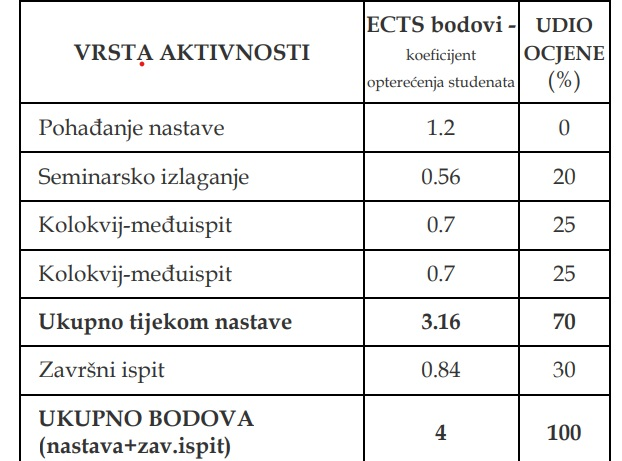Kolegij
Studiji
PovijestKomunikologija
Psihologija
Sestrinstvo
Sociologija
Sestrinstvo
Studijska godina
1ISVU ID
235244ECTS
4
The course aims to acquaint students with the origin and development of European cities in the context of general historical processes and the development of urban planning. A comparative analysis of the development of European cities will present the basic characteristics of development and evaluate their main features with regard to chronological, geographical conditions, regional affiliation and cultural circle affiliation.
Content: The course provides an overview of the development and structure of European cities from antiquity to the 19th century. Using the examples of different European cities, the course presents the main features of topography, functional and morphological structure. Specific historical periods and social structures influenced the creation of a specific spatial structure of the city. Thus, we distinguish the characteristic stages in the development of the city: the ancient period, the Middle Ages, the early modern period from 1500 to 1800. Cities will also be analyzed with regard to geographical characteristics (Mediterranean city, Central European city, Scandinavian city, etc.), size (metropolis, small cities), topography (port cities, island cities, etc.), special circumstances (wars, epidemics, earthquakes), regarding the foundation (royal cities, monastery cities, satellite towns). The emphasis of the lecture will be on selected European cities and on comparative Croatian examples.
1. Ovladati temeljnim historiografskim pojmovima vezanim uz urbanu povijest i spoznati važnost interdisciplinarnog pristupa problematici. 2. Održati jasno i strukturirano složeno usmeno izlaganje. 3. Aktivno i argumentirano sudjelovati u raspravi. 4. Koristiti se suvremenim informacijskim i komunikacijskim tehnologijama i vještinama komuniciranja.
a B. Milić, Razvoj grada kroz stoljeća, Prapovijest – Antika, Zagreb 1994. (odabrana poglavlja); B. Milić, Razvoj grada kroz stoljeća, sv. II, Srednji vijek, Zagreb 1995. (odabrana poglavlja); B. Milić, Razvoj grada kroz stoljeća, sv. III, Novo doba, Zagreb 2002. (odabrana poglavlja).
P. Clark, European cities and towns, 400-2000, Oxford University Press, 2009; M. Suić, Antički grad na istočnom Jadranu, Zagreb 2003. (odabrana poglavlja); T. Raukar, „Srednjovjekovni grad na istočnom Jadranu: prostor i društvo“, u: Spomenica Ljube Bobana (ed. Nikša Stančić), Zagreb: Zavod za hrvatsku povijest Filozofskog fakulteta Sveučilišta u Zagrebu, 1996, 35-48; D. Miletić, Plemićki gradovi kontinentalne Hrvatske; Tomislav Raukar, Hrvatsko srednjovjekovlje, Zagreb 1997. (odabrana poglavlja); C. Gates, Ancient Cities, Routledge, New York 2003. (repr. 2011.);. P. M. Hohenberg i L. Hollen Lees, The Making of Urban Europe: 1000-1994, Cambridge-Massachusetts-London 1996; S. R. Epstein, ur., Town and Country in Europe, 1300–1800, Cambridge: Cambridge University Press, 2001; T. Marasović, „Srednjovjekovni urbanizam hrvatskih gradova na Jadranu“, u: Hrvatska i Europa: kultura, znanost i umjetnost. sv. 2, Srednji vijek i renesansa (XIII-XVI stoljeće), ur. I. Supičić i E. Hercigonja, Zagreb: HAZU & AGM & Školska knjiga, 2000, 527-551; D. Jelaš, „Tipologija srednjovjekovnih gradskih naselja u donjem međurječju Drave i Save“, u: Povijesni Zbornik 5 (2012.), str. 33-50; I. Benyovsky Latin, „The Venetian Impact on Urban Change in Dalmatian Towns in the First Half of the Fifteenth Century“, u: Acta Histriae 22/3 , 2014, 573-616; A. Mohorovčić. Razvoj naselja i gradova na području sjeverne Hrvatske. Zagreb, Hrvatska i Europa, sv. I, 2000, 553- 583; R. Vučetić, Prostorna struktura srednjovjekovnih gradskih naselja u Hrvatskom Zagorju i njihov razvoj do Prvog svjetskog rata, magistarski rad, 2002.
- Redovito pohađanje nastave – prisutnost na najmanje 70% nastave prema studijskom programu i izvedbenom nastavnom planu; 2. Uredno izvršene seminarske obveze – pripremljeno izlaganje te predana i prihvaćena pismena verzija seminarskog rada; 3. Stjecanje minimalnog uspjeha od 35 % tijekom nastave unutar zadanih nastavnih aktivnosti – ostvareno kumulativno.
1. Nastavne aktivnosti – seminarske obveze; 1. kolokvij (pismeni) i 2. kolokvij (pismeni); 2. Završni ispit (pismeni).
Brojčana ljestvica ocjenjivanja studentskog rada: nedovoljan (1) – 0 do 49,9% dovoljan (2) – 50–64,9% dobar (3) – 65–79,9% vrlo dobar (4) – 80–89,9% izvrstan (5) – 90% i više
a) Nastavne aktivnosti – 70 % ocjene seminarske obveze – 20% (izlaganje – 8%; predana i prihvaćena pismena verzija – 12%) kolokvij – 25% kolokvij – 25% b) Završni ispit – 30% ocjene (za prolaz je nužno riješiti 50% ispita) pismeni ispit – 30%

| Akademska godina | |
|---|---|
| 2024/2025 | Download |